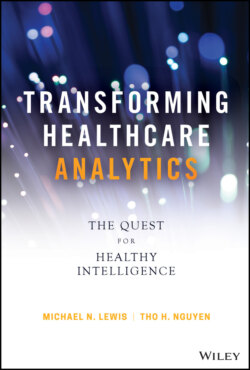Читать книгу Transforming Healthcare Analytics - Michael N. Lewis - Страница 12
HEALTH DATA DEFINED
ОглавлениеMany years ago when I was a child, I could recall sitting in my doctor's office as my parents filled out forms about me and my health that contained fields such as name, date of birth, address, Social Security number, medications that I was taking, what is the purpose of this visit, and history of family members for each visit to each type of clinician. All of these forms have been kept in a folder that can stack up as high as the ceiling and stored in file cabinets (see Figure 1.1). When you visit the doctor and hospital, they retrieve those records, sift through all of that historical data, and review them to assess your condition. As the nurse called my name to go back to see the doctor, they would measure my weight, my blood pressure, and body temperature – all of these data points were also captured and entered in my file. Once the doctor was ready to see me, he would ask me some simple questions based on the information provided on the forms. At the same time, the doctor also evaluated and observed my physical and emotional attributes to see if any of these intangible factors provided any insights to my wellbeing, both physically and emotionally. From my pediatrician to my current doctor, all of my records have been maintained in some manner.
This photo by an unknown author is licensed under CC-BY-2.0.
Figure 1.1 Storage of Your Medical Records
Source: S.J. Howard, 2010. https://sjhoward.co.uk/in-support-of-a-national-nhs-computer-system/. Licensed under CC-BY-2.0.
With technology advancements, these forms can now be scanned, notes from paper can be entered into computers, and observations get captured in a dialogue – all of which can now be archived in electronic health systems. As I have gotten older, I had to fill out the same forms myself with the identical data points and the repetitive information continued to get captured. If you are a healthy person, you would visit your doctor once a year for a wellness checkup; otherwise, you may have additional visits when you get a cold, cough, or an injury. Unfortunately, if you encounter a serious illness such as injury, cancer, stroke, or a heart attack, x-rays and magnetic resonance imaging (MRI) are needed and these images are combined with your other data points to diagnose a problem and plan a treatment. All of these health data are kept from year to year, from birth to end of life, and become very voluminous and complex.
Thus, health data is defined as any data that relates to your health and comes from many sources such as behavioral observations, environmental factors, and socioeconomic data. Health data can be structured or unstructured. For example, your name, date of birth, blood type, or gender is considered as structured data and can be standardized in columns and rows. Most structured data can be stored in a data warehouse. Unlike structured data, unstructured data such as your doctor's notes, x-rays, MRIs, audio recordings, or emails are not standardized and have become more prevalent. Unstructured data are typically not stored in a data warehouse and require a different data storage mechanism. All structured and unstructured health data are collected over time to help understand the past, assess the present, and foresee the future of your health.
Besides our own personal health data, other health data sources can come from clinicians, pharmacies, labs, hospitals, health agencies, and devices (mobile) as described below and shown in Figure 1.2:
Clinicians – an encounter with your family physician, specialist doctor, physician assistant, or nurse that examines your condition and recommends a cure for a diagnosis.
Pharmacies – medications that are prescribed by your doctor to maintain your health or cure an illness and distributed at your local or online pharmacy. It can be generic as antibiotics to destroy bacteria or specific as lowering your blood pressure. These prescriptions are captured and regulated to avoid possible abuse.
Labs – this can be as simple as blood work to determine your blood type, cholesterol level, vitamin deficiency, or as complex as tests to determine if you are a sickle cell anemia carrier. Each lab work is carefully analyzed and the results are reported to your doctor for diagnosis.
Hospitals – visits to the hospital that normally require a doctor's attention for more serious procedures such as heart surgery, removal of a tumor, or giving birth.
Health agencies – agencies such as Centers for Disease Control (CDC) or National Institute of Health (NIH) provide medical research using our health data to control the spread of diseases or find cures of deadly diseases so that we can live longer and healthier.
Devices (mobile) – these can be both apparatus that gets installed in your body or wearables on your wrist to collect vital data such as heartbeat, blood pressure, number of steps, etc.
Figure 1.2 Sources of Health Data: From Paper to Digital
Source: Author.
